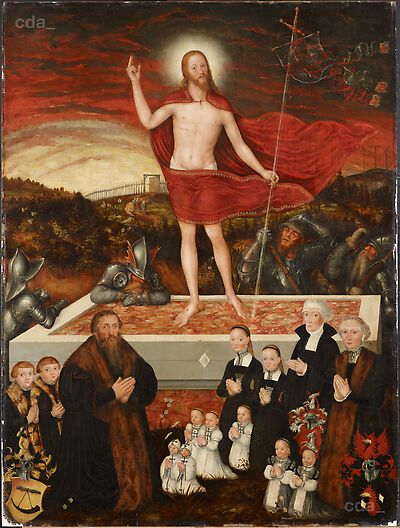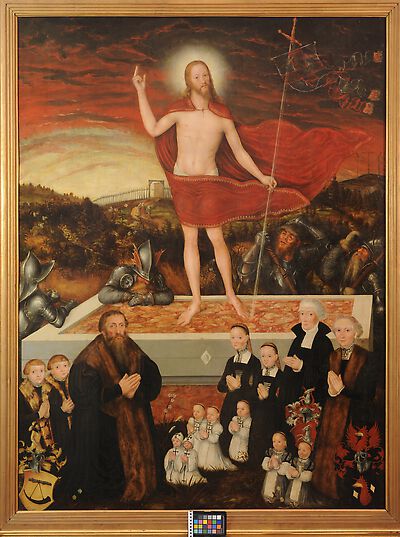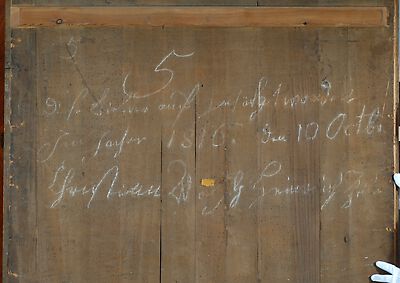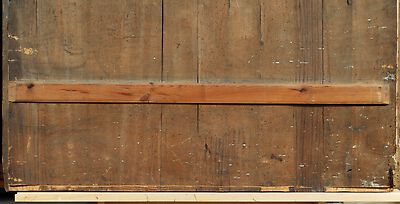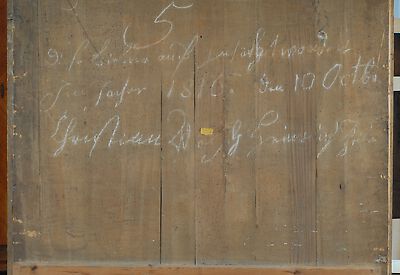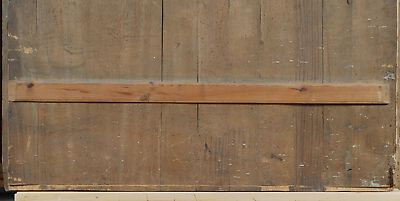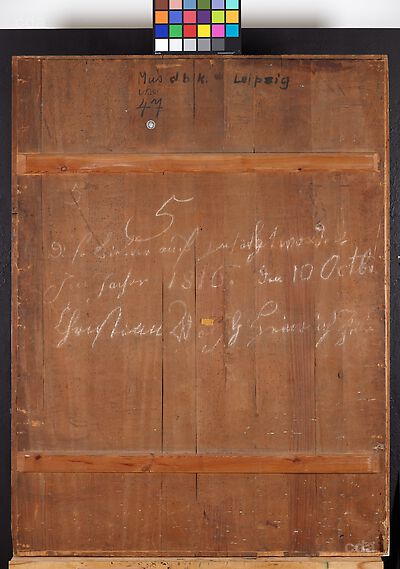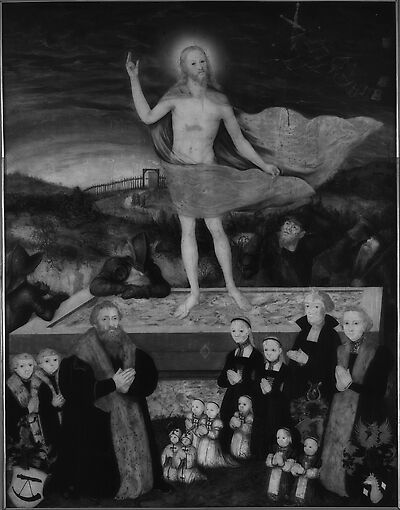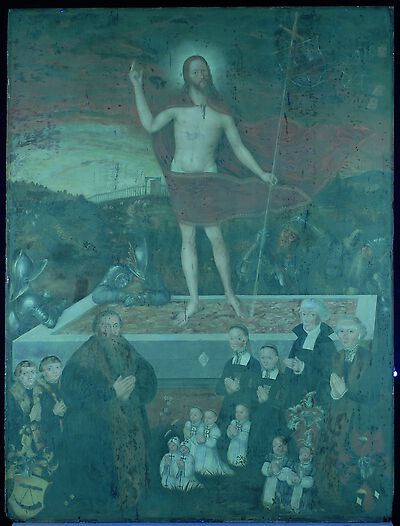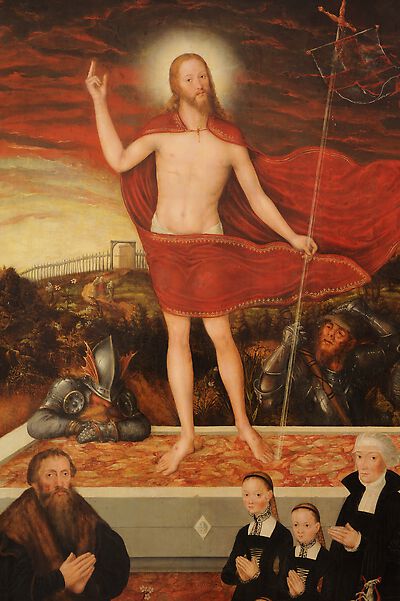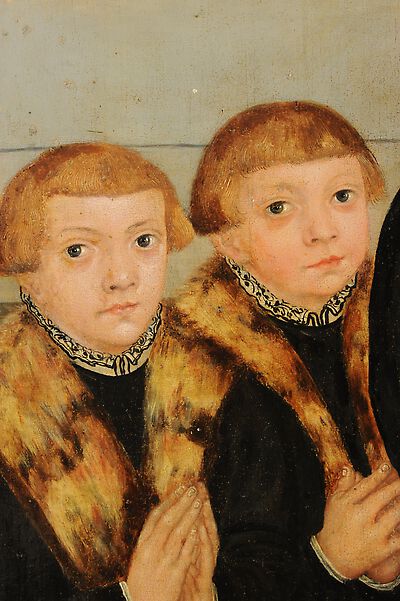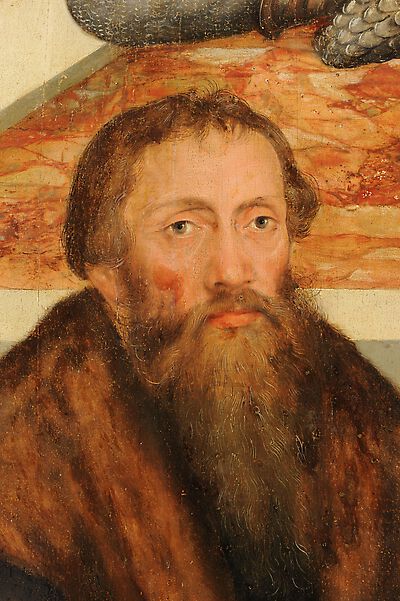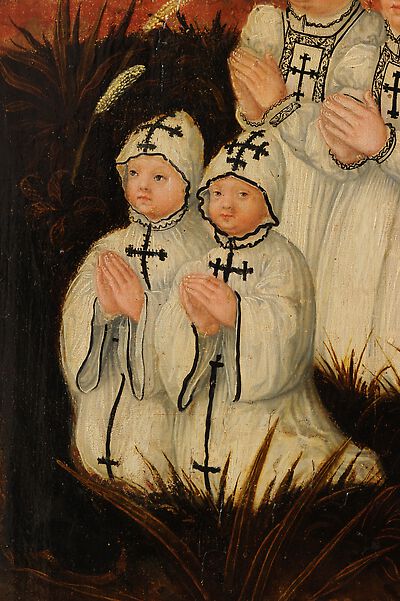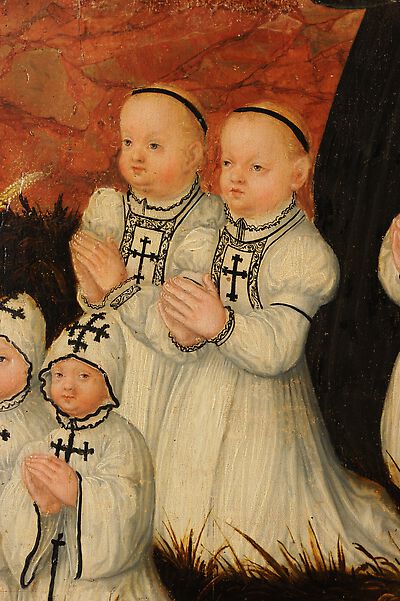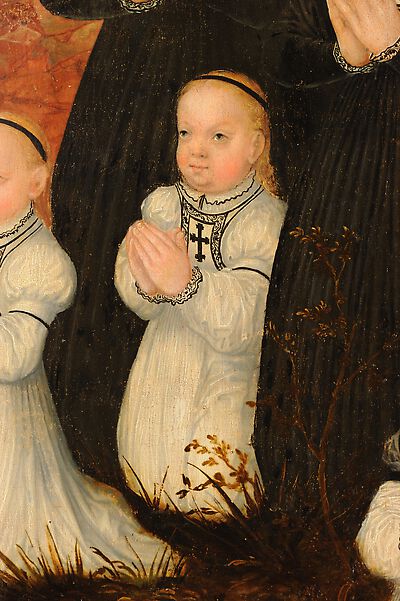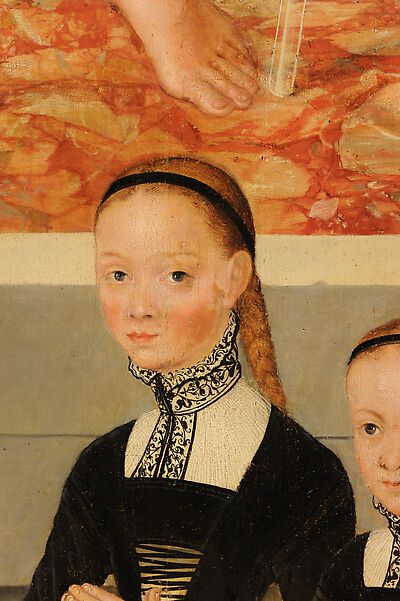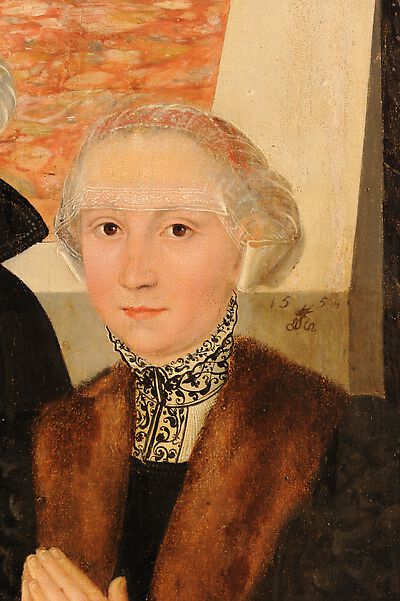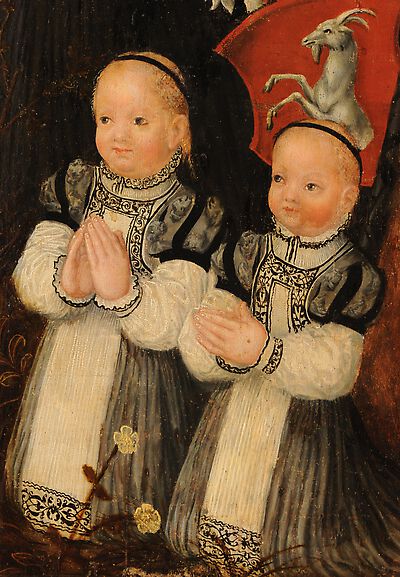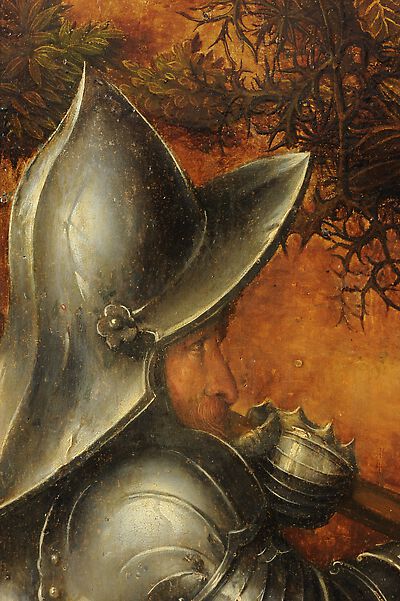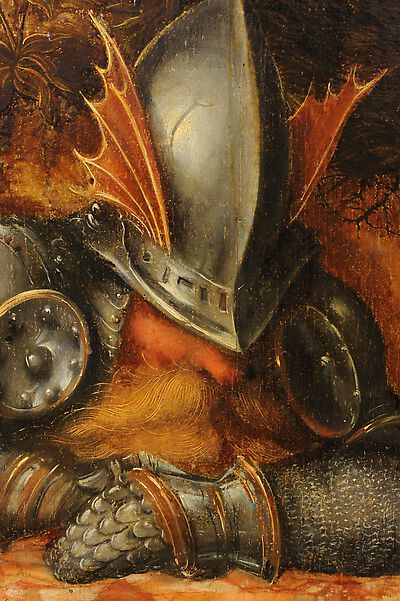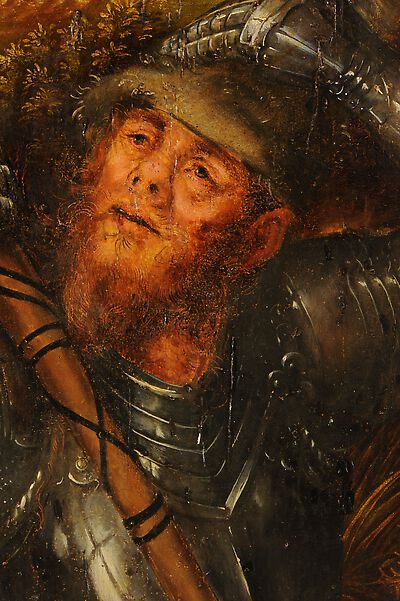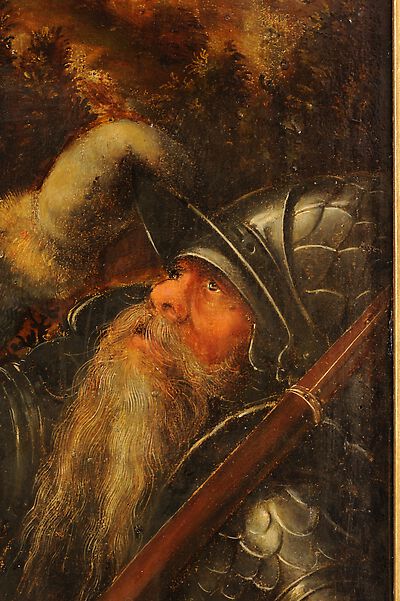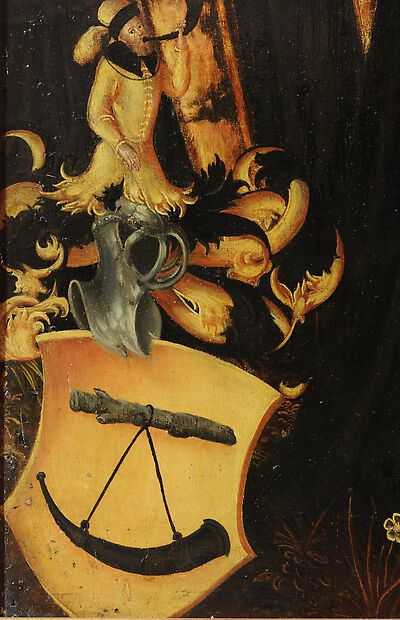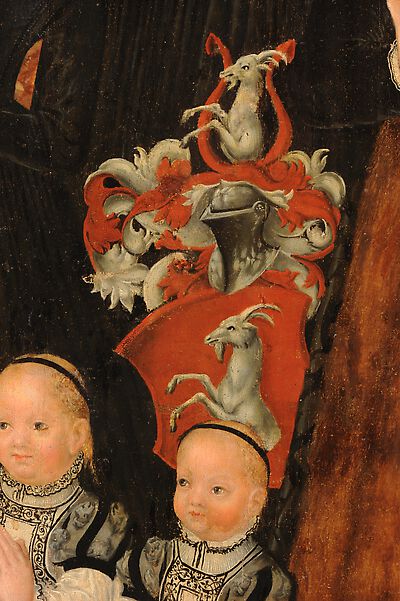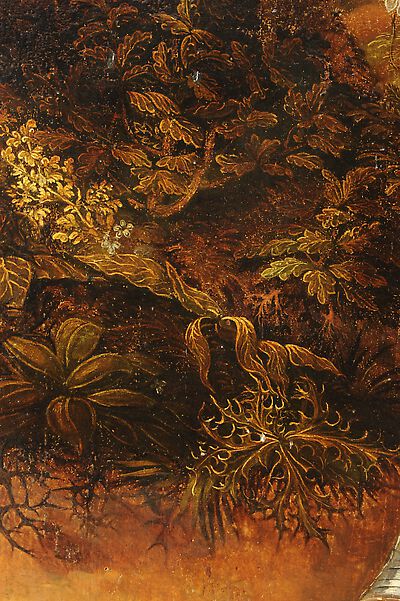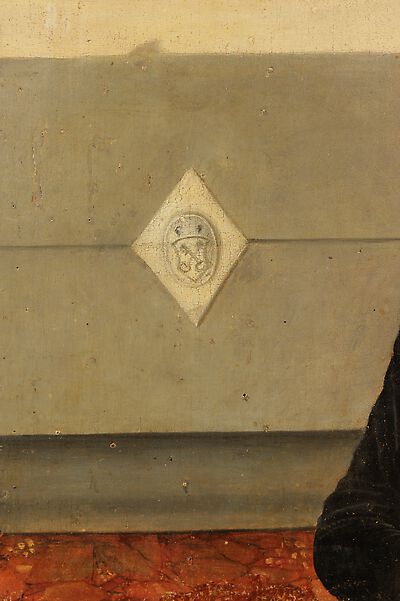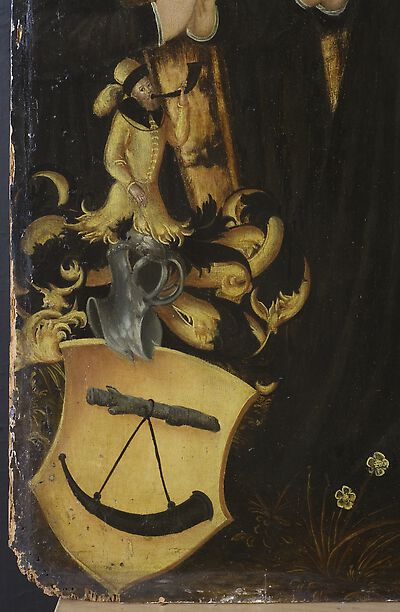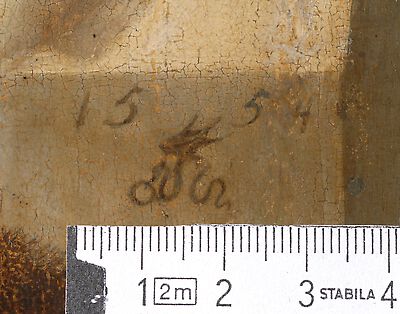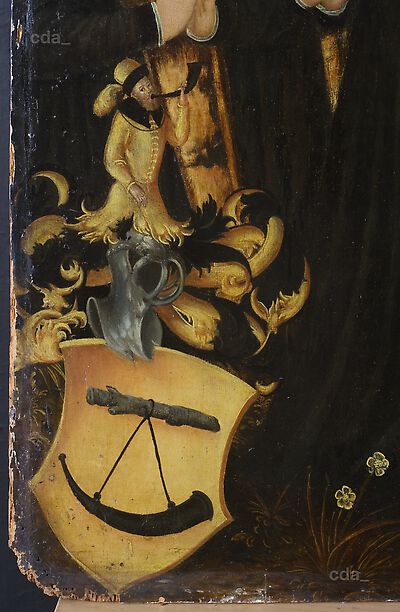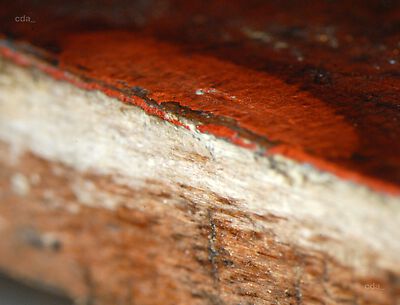Support
- limewood (Tilia sp.). Identification of wood species by Manfred Becker (conservator), Berlin, probably in the early 80s. Identification of wood species by Dr. Peter Klein, Hamburg, report from 26.10.2013 in der conservation file
- 11 vertically aligned boards with butt joints. On the recto vertical marks from a plane are visible in raking light.
- one knot at the left at the edge, two knots further in
- board widths: I: 11.2cm/9.6 cm, II: 15.2 cm/15.1 cm, III: 12.7 cm/10.4 cm, IV: 12.9 cm /12.5 cm, V: 11.4 cm /10.0 cm, VI: 9.6 cm, VII: 9.7 cm /9.6 cm, VIII: 10.2 cm /9.4 cm, IX: 9.6 cm/9.1 cm, X: 9.2 cm/8.9 cm, XI: 16.0 cm /15.1 cm
- the joins were reinforced in 1816, two horizontal cross-members
- vertical marks from a block plane are visible over the entire reverse of the panel. Occasional marks from a chisel (e.g. board 9). Finally the entire surface was smoothed with a simple plane.
- there is a rebate on all four edges (c. 1.5 cm deep, 2 cm wide). Marks from forged nails (e. g. at the top right) probably from the fittings for the original frame.
- trimmed at the left and bottom edges, the rebate has been removed completely at the bottom (c. 1.5 to 2 cm). Along the top edge the endgrain has been minimally reworked, here there is in part a slight bevel towards the painted side.
Ground and Imprimatura
- white ground, probably chalk/glue (not tested)
- thin
- along the top edge a barb from a former working or decorative frame has been retained. Here the ground occasionally extended beneath the frame (see detail photograph). The barb exhibits an irregular relief form from smooth to sharp edged, and is c. 3-5mm from the top edge. Remnants of a barb are visible along the right edge and cover the edge with a slight ridge. These remnants appear to be where the excess load on the brush employed to apply the ground was wiped off (see photomicrograph)
- faint brushstrokes are visible in the sky (from the ground application, irregular and predominantly in the vertical direction
- no imprimatura
Underdrawing
- probably executed with a metal point (lead) or a stylus. The contours are economically described and some details are indicated (like the chest muscles and the rib-cage in christ's torso).
- the underdrawing is faintly visible to the naked eye beneath the flesh paint
- in the figure of Christ there are alterations in the position of the loin cloth, the belly-button, and the positionof the fingers on the right hand.
- pouncing marks are visible in the underdrawing of the loin cloth
Paint Layers and Gilding
- macroscopic and microscopic examination of the surface, the edges of the painting and the panel; small cleaning tests in the area of the frame rebate; sampling along the edge: at the right, centre, the bottom left and the top right corner ; cross-section to establish the paint layer structure
- the dark areas in the sky were underpainted in grey. The landscape was initially laid in with brown and grey toned washes to a semi-opaque application.
1. Initial application after the underdrawing:
grey to greyish-brown washes, the flesh paint and white areas were held in reserve, e. g. the sarcophagus, the garments where light
2. Sky:
the underpaint was executed with dark grey paint becoming lighter further up. Subsequently a light yellow admixture of opaque to semi-opaque paint was applied and red was blended wet-in-wet. The dark grey at the top edge is a single paint layer (see underpaint). Over this a red tone was applied wet-in-wet. The highlights in the clouds are impasto.
3. Garments, Armour:
with the exception of the white garments and the fur collar an opaque, relatively thick paint application was employed, subsequently the highlights were applied wet-in-wet, and details in impasto. The white garments were laid in with lead white. The folds were modeled with grey glazes and blackish-grey tones. Highlights were applied with thick impasto employing lead white , other details were added using opaque black paint.
4. Landscape:
initially laid in with grey to greyish-brown washes. Vegetation in part unmodulated underpaint in light green admixtures, opaque to semi-transparent, but also occasional luminous green washes. subsequently the shapes of leaves (contours), grass and branches were added employing light yellow, yellowish-green or brown admixtures (frequently impasto). Over these in part green glazes.
5. Flesh paint:
the shadows were laid in with a grey wash, finely dabbed on or blended. for the highlights the ground was left exposed (without a distinct boader to the shadows) and the transition to the greyish-brown admixture of the hair is fluid (the hair was laid in wet-in-wet with semi-opaque brown tones). After the drying process the flesh tones were applied. In the lighter areas these were applied as an opaque layer and blended very soft, over the grey underpaint a semi-opaque application was employed, allowing the underpaint to shine through. The red for the cheeks and light highlights were blended wet-in-wet. The deeper shadows in the flesh paint and the hair were thinly applied with blackish-brown glazes and delicately dabbed and blended. Finally delicate fine highlights, contours and the tips of the hair were added.
- in all flesh paint glazed to semi-opaque application, blended with no brushstrokes visible. Very delicately dabbed aplication in the shadows. In parts of the landscape, the fur and the hair semi-opaque brown tones. Highlights like for example in the armour and the white garments opaque to impasto application. Also in impasto: all the light contours, the ornamentation, the strands of hair and the highlights. Large colour flieds were painted with a broad brush, for example the edge of the sarcophagus or the different painted sections of the sky, where faint brushstrokes are visible.
- in the flesh paint thin to very thin application otherwise the consistency is relatively opaque and in part very thick like in the sky. The paint application in the fur and hair of the sitters is glazed to semi-opaque. The red glazes have faded, e. g. the fur of the two boys on the left. A broad animal-hair brush probably employed for the sky and the garments. Very small, short pointed brushes were used for the fur, the hair and the vegetation. Larger, softer animal-hair brushes were used to blend the paint.
- the paint was brushed out along the right edge of the panel, see photomicrograph
- the green glaze has turned brown. There is an increased transparency in the flesh paint, the brown tones in the landscape and the fur collar. The white glaze on the banner and in parts of the headscarf of the woman at the bottom right have also increased in transparency.
Framing
- not original, probably from about 1848.
- dimensions: 186 x 146 x 6 cm
- pine wood
- colour: gilded, flat plate matt, patinated half-rounded battens silver gilded with a gold glaze. Construction: frame with inlays. The rebate is an inlay (probably original). The corner joins are mitred and overlap on the reverse. Decoration: on the front flat plate two parallel half-roundedbattens crossing at the corners.
[Museum der bildenden Künste, 11.06.2014]
